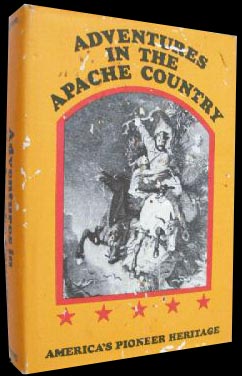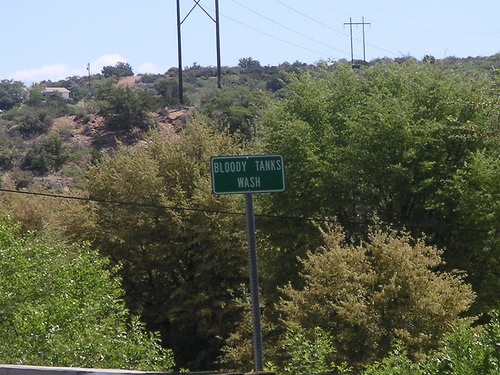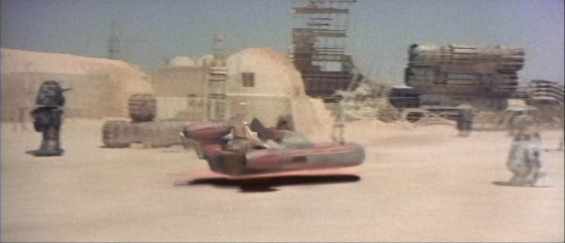Adventures in the Apache Country
J. Ross Browne (1871)
But why is it, you cunningly ask, if the silver mines of Arizona are as rich as they are represented to be, that they are now deserted? Why have they failed to attract a mining population? Why has Arizona made no progress within the past ten years, while Washoe and Idaho have made such rapid strides within three or four years? Let me answer these inquiries by a brief reference to the past and present condition of Arizona. It is true that the silver mines of Washoe attracted a population of ten thousand during the first year of their discovery; also true that Idaho now boasts a population of twenty thousand; while the melancholy fact can not be denied that Arizona has never yet had an American population of over three thousand, and not a very good one at that. (14)
At the period of its purchase Arizona was practically a terra incognita. . . Few people in the United States knew any thing about it, save the curious book-worms who had penetrated into the old Spanish records. An impression prevailed that it was a worthless desert, without sufficient wood or water to sustain a population of civilized beings. (16)

It was inhabited almost exclusively by savage tribes of Indians, from whose ravages the Texans and Mexicans had long suffered; and now, if our surplus of adventurous politicians could only be sent there, the more valuable of our possessions would no longer be subject to their injurious machinations. (17)
Arizona possessed at least the pretense of military protection. It soon became infested with the refuse population of Sonora—the most faithless and abandoned race, perhaps, on the face of the earth. What the Apaches left undone in the way of murder and robbery they seldom failed to complete, and indeed were regarded with more distrust by respectable citizens than even the barbarous Indians. (22)
During the month of July [1861] the only Federal troops in the Territory shamefully and without cause abandoned it. . . . Without waiting to ascertain the number of prepare for any defense, they burned all their wagons, spiked their cannon, and packed their provisions over the mountains to Fort Craig. . . . The hostile Indians, ignorant of our domestic disturbances, believed they had at length stampeded the entire white population. On the public highways they fell upon small parties and slaughtered them. It was their boast, and is still their belief, that they had conquered the American nation. (24, 25)
Don't expect me to be lively in such a wild region. It is not a jolly country. The graves of murdered men, and boundless sand deserts, and parched mountains, and dried-up rivers, and scenes of ruin and desolation are profoundly interesting; but they are not subjects for the indulgence of rollicking humor. It is only serious and reflecting men, like you and myself, who can appreciate them. (27)
My friend Poston, as already stated, had travelled through Arizona before, and his notions of the physical necessities of man in that region were some what extravagant. Not that he was unreasonably addicted to comfort, but he delighted in a species of practical satire which usually cost him a considerable sum of money, not to say an endless amount of trouble. Arizona, he said, was an extensive country, prolific in reptiles and precious metals, but painfully destitute of every thing for the convenience of civilized man. (38)
Yet, strictly speaking, the Colorado is scarcely a desert. Extensive belts of rich soil, that irrigation would render productive, occupy a large portion of the country. In these are seen the evidences of sudden and extraordinary vegetable growth in seasons of abundant rain, or when the Colorado River overflows its banks. A proposition has been entertained by Congress to reclaim this vast tract of country, embracing millions of acres of rich agricultural land, by means of a grand canal from the Colorado, with a connected system of acequias. (48)
[This plan was later realized as the Central Arizona Project boondoggle]
It is said that a wicked soldier died here, and was consigned to the fiery regions below for his manifold sins; but unable to stand the rigors of the climate, sent back for his blankets. (56)
Neither threats nor presents, nor offers of unlimited reward could induce the wily savages to guide the white men to these fabulous regions of wealth. "Why should we?" said they—and with good reason—"you are already taking our country from us fast enough; we will soon have no place of safety left. If we show you where these yellow stones are, you will come there in thousands and drive us away and kill us." (69)
In crossing the [Gila] river, which appeared to be only a few inches deep, our animals sank in a bed of quicksand, and had a fearful struggle before they could gain the opposite bank. (83)
The first night we spent at Sacatone Station, from which the Tucson road diverges across the ninety-mile desert. Following the banks of the river next morning through dense groves of mesquit, keeping in view, a little to the left, a peculiar conical peak, which forms a prominent landmark. . . . We struck out through the mesquit groves, and in about half an hour's ride from the river reached the famous Casas Grandes of the Gila. . . . I saw no hieroglyphics in the building except the names of some Texan adventurers and California Volunteers, scribbled with a piece of charcoal. Rude sketches of Jeff Davis hung by the neck and President Lincoln fleeing from the vengeance of the Chivalry indicated rather forcibly that we were not beyond the reach of sectional prejudices. . . . We spent half a day very pleasantly in exploring these interesting ruins, and took our departure for the camp on the Gila late in the evening, well laden with curiosities. Every member of the party had his fragment of pottery and specimen of adobe and plaster. (114, 118, 120)
Mr. Dye states that when they came close enough to talk they were very bold in their manner, and said, tauntingly: "We are your enemies; we have stolen your horses and cattle; we have killed you whenever we could; and will continue to kill you whenever we meet you. If you are not squaws, come on and fight us." After a long talk, and the profession of peaceful intentions on the part of Woolsey and his command, the Indians were finally persuaded to come into camp. Most of them laid down their arms outside as directed; a few secreted their bows and arrows under their serapas. . . . These were the preliminaries of an Arizonian "treaty." Then Woolsey called up eight of the Maricopas and stationed them that they should assist in signing the document. The white men were drawn up on the right, and were instructed to
be "on hand." These movements created a good deal of suspicion. The strange Indians were evidently uneasy. For a moment there was a death-like silence. Suddenly Woolsey drew his pistol, levelled it, and shot Par-a-muck-a dead on the spot. This was the signal for the signing of the treaty. Simultaneously the whole party commenced firing upon the Indians, slaughtering them right and left. Lennan stood in advance of the Maricopas, and was warned by Woolsey to make sure of a lame Indian with a lance, who was eying [sic] him suspiciously. "I'll look out for him," was Lennan's reply; and the slaughter became general. Those of the Indians who were not shot down instantly fought with desperation, retreating a little way and then turning back. Some of them kept running, and shot their arrows as they ran. The fight, if such it could be called, lasted seven or eight minutes. These were found to be Tonto and Pinal Apaches. Four of them were recognized as Pinals, belonging to the tribe of Mangus Colorado. Twenty Tontos and four Pinals lay dead upon the ground. . . . The scene of this massacre has been appropriately named the "Bloody Tanks." (122-3)

It has been my fortune to furnish the world with sketches of Madagascar, Zanzibar, Palestine, the Continent of Europe, Iceland, and some few other points, many of which were achieved under circumstances of peculiar difficulty; but I never before travelled through a country in which I was compelled to pursue the fine arts with a revolver strapped around my body, a double-barreled shot-gun lying across my knees, and half a dozen soldiers armed with Sharpe's carbines keeping guard in the distance. Even with all the safeguards of pistols and soldiers I am free to admit that on occasions of this kind I frequently looked behind to see how the country appeared in its rear aspect. (125)
Pimo belles were in their glory. Plump and good-natured; their pretty eyes fringed around with black paint; their teeth shining in pearly whiteness; their bosoms bare; their forms of almost Grecian symmetry and delicacy. Poston, with his enthusiastic appreciation of beauty, would have lost his balance completely had I not warned him of the dangers that surrounded him; so that when severely pressed by a bevy of Pimo maidens for beads, calicoes, and the like, he usually closed both his eyes and handed out the presents at random. (127)
The country between the Gila River and Tucson is a hard, gravelly desert, partially covered with a scrubby growth of mesquit and cactus, and at this season destitute of water except at two or three points, where the wells dug by the Overland Mail Company still remain. (129-30)
The Pecacho lies forty-five miles from the Gila, and is about the same distance from Tucson. It presents a prominent and picturesque landmark from both points, and is seen at a great distance from the Papagoria. The name is Spanish and signifies "point," or "peak." Some travellers have discovered in this curious formation of rocks some resemblance to an axe-head. There are many Pecachos throughout Arizona. I have been unable to see in any of them the most remote resemblance to an axe-head. Generally they consist of two sharp-pointed rocks, one of a triangular and the other of a rectangular shape, growing out of the top of some isolated mountain, and serve to indicate the routes across the desert, which would otherwise be difficult to find. (130)
It is gratifying to find that travel in many lands has not yet fatally impaired my capacity for receiving new sensations. Virginia City came near it; but it was reserved for the city of Tucson to prove that the world is not yet exhausted of its wonders. (131)
As the centre of trade with the neighboring State of Sonora, and lying on the high-road from the Rio Grande to Fort Yuma, it became during the few years preceding the "break-up" quite a place of resort for traders, speculators, gamblers, horse-thieves, murderers, and vagrant politicians. Men who were no longer permitted to live in California found the climate of Tucson congenial to their health. If the world were searched over I suppose there could not be found so degraded a set of villains as then formed the principal society of Tucson. (133-4)

A sojourn of two or three days quite satisfied us with the metropolis of Arizona. (138)
On the 19th of January we set forth on our journey with an escort of thirty men belonging to Company G, California Volunteers, under command of Lieutenant Arnold. I may here be allowed to say that a better set of men I never travelled with. They were good-humored, obliging, and sober, and not one of them stole a pig or a chicken during the entire trip. (139)
Tubac is now a city of ruins—ruin and desolation wherever the eye rests. Yet I can not but believe that the spirit of American enterprise will revisit this delightful region, and re-establish, on a more permanent footing, all that has been lost. (149)
During the night we were visited by a detachment of the common enemy, evidently on a tour of observation. Next morning their tracks were visible in the road near the river, showing how they had come down and where they halted to inspect the camp, as also their return. Their purpose evidently was to steal our horses; but they must have seen the sentinels and concluded it would not be a safe investment of time or labor. Had the command been less vigilant we would doubtless have made the remainder of our tour on foot, as many a command has already done in this country. Pleasant prospect, is it not? where one stands an even chance of being shot with a rifle-ball or an arrow as he sleeps, and does not know when he wakes up but he may have to cross deserts and mountains on foot before he reaches any point inhabited by white people. But I suppose in war-times, when men are slain every day by thousands, such incidents must appear very tame and commonplace. A few years ago I would have regarded my tour through Arizona as something of an achievement. Now I write the details with a humiliating consciousness that they are scarcely worthy of record, except as pictures of every-day life in a country but little known. (156-7)
We stopped awhile at the boundary-line to examine the monument erected by Colonel Emory in 1855. Very little of it now remains save an unshapely pile of stones. Wandering bands of Sonoranians, in their hatred of every thing American, had doubtless mutilated it as an expression of national antipathy. These people say they never consented to the sale of any portion of Sonora, and still regard Arizona as legitimately a part of their territory.
I could not help regretting, as I looked beyond the boundary of our territorial possessions, that we had not secured, by purchase or negotiation, a line sufficiently far south to afford us a port on the Gulf of California. Without such a port Arizona will always be difficult of access. (159)
We stopped awhile at the village and mission of San Ignatio, to examine the ruins and witness a horse-race which came off during the day. There was but little to interest us in the race. The horses were wretchedly poor, and looked much more disposed to die than to run races for a wager. In truth, horse-flesh is in rather a low condition just now in Sonora. The best horses are all in possession of the Apaches. Kuchies [Cochise], the famous chief and warrior of the Pinals [Chiricahuas], rides the finest horse in the country. These vagabond Indians have a saying, no less sarcastic than true, that the Mexicans are their vaqueros, upon whom they depend for their horses and cattle; and that the Americans are their teamsters and mechanics, who haul goods for them and supply them with arms. (166)
|



